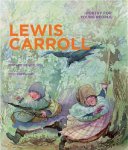Through the Looking Glass Children's Book Reviews
Poetry for Young People: Lewis Carroll
Illustrator: Eric Copeland
Poetry Picture Book
For ages 8 and up
Sterling, 2008 ISBN: 978-1402754746
Charles Ludwidge Dodson was a mathematician who taught and studied at Oxford University. He was greatly respected, and was a serious scholar who lived a quiet life. However, this tall thin young man had a silly and playful side, a side that chose to write fantastical stories and poems under a pen name. As Lewis Carroll, he was able to break free of his college teacher life and indulge in creating colorful characters, ridiculous situations, and amusing poems.
Though Charles wrote little stories and poems when he was living with his family and later, his writing adventures really began on July 4th, 1862, when he was thirty years old. On this day he went for a picnic and went rowing on the River Thames with friends. One of the picnickers was a ten year old girl called Alice, and he made up a story for her and the other children about a girl called Alice who jumped down a rabbit hole. This story would, sometime later, get turned into a book called Alice in Wonderland. A sequel followed that was called Through the Looking-Glass.
In this splendid book the editor looks at many of the poems from these two books, plus excerpts from Carroll's poem The Hunting of the Snark, poems from his novel Sylvie and Bruno, and other poems that he wrote during his life.
In many of his poems Carroll finds ways to make fun of conventions that were popular in his time. For example, many poets liked to write poems that encouraged children to work hard, to be good, and to do as they are told. In How Doth the Little Crocodile, Carroll parodies a poem someone else wrote about “the little busy bee” that works hard to collect nectar “from every opening flower.” In Carroll's version we meet a crocodile who, with a big and wide grin, “welcomes little fishes” to swim into his tooth-filled jaws.
In A Sea Dirge Carroll makes fun of all those popular poems that waxed eloquent about the sea. As far as Carroll is concerned, the sea is a place where you get wet feet, a case of seasickness, and ruined food because sand gets in your tea. It is a place where one might fall down a cliff, slip on some rocks, and where one has to put up with having to watch nannies and their charges and other similarly unpleasant sights.
Throughout this excellent collection, each of the poems are introduced by a note from the editor and they are accompanied by wonderful paintings, all of which beautifully capture the essence of the poems.




